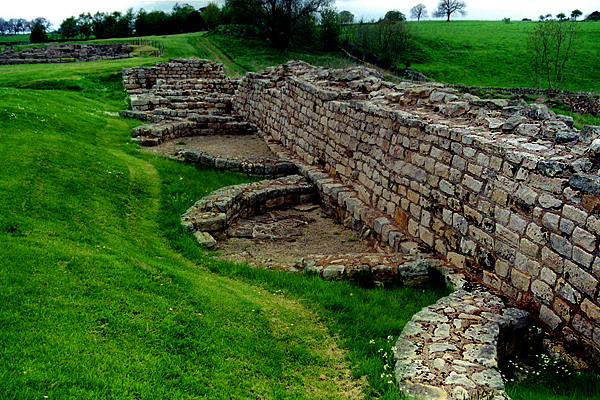

"The Britons are unprotected by armor. There are very many cavalry. The cavalry do not use swords nor do the Brittunculi mount in order to throw javelins."
Vindolanda tablet, c. AD 92
On the pretext that the Celts in Britain were reinforcing and offering refuge to their kinsmen in Gaul, Caesar sent expeditions to that island in 55 and 54 BC to reconnoiter (IV.20ff). There he confronted the native Britons. Caesar does not characterize them (as he denigrates the Gallic Celts) but speaks only of their military tactics: how they fought from chariots in open formation, the horses and noise of the wheels inspiring terror, driving over the field, hurling their javelins and even standing on the yoke of the chariot, or intentionally giving ground, only to dismount and fight on foot, with reserves posted to cover a retreat or to replace exhausted men.
Claudius invaded Britain in AD 43, again, for political reasons. The Britons were farmers without the training or the discipline of the Romans, and only those with land could afford chariots and the horses to draw them. In one of the wooden writing tablets from Vindolanda, circa AD 97-105, a Roman soldier describes the fighting equipment and tactics of the native tribes, whom he dismissively characterizes as Brittunculi, "wretched little Brits." The patronizing word is used here for the first time. The letter may be a military report or an observation on the suitability of the natives as recruits or simply remarks left by an officer for the benefit of his successor. One does sense an exasperation with warriors who do not wear armor or fight in the Roman fashion, throwing their javelins from fixed positions and using swords with their cavalry.
Tacitus also writes about the Britons in Agricola (AD 98), a biography of his father-in-law, who was governor of Britannia from AD 77-83/84. The natives fight from chariots, he says, a panic-stricken horse without a driver often hurtling into the men; nor are their long, unwieldy swords suitable for thrusting in close combat. Unable to cooperate among themselves, each tribe fights on its own and all are conquered. As to the Gallic peoples in Britain, they have a hardiness in confronting danger but cowardice in shirking it. The unconquered Britons show more spirit, he confesses, not having been made soft by peace and the loss of liberty. But, even if broken to obedience, they are not to slavery and abuse (XI-XIII). The bravest, however, also served as auxiliaries at Mons Graupius (XXIX).
If the anonymous author of the Vindolanda tablet is critical of the Britons, Strabo was barely less contemptuous.
"The men of Britain are taller than the Celti, and not so yellow-haired, although their bodies are of looser build. The following is an indication of their size: I myself, in Rome, saw mere lads towering as much as half a foot above the tallest people in the city, although they were bandy-legged and presented no fair lines anywhere else in their figure. Their habits are in part like those of the Celti, but in part more simple and barbaric— so much so that, on account of their inexperience, some of them, although well supplied with milk, make no cheese; and they have no experience in gardening or other agricultural pursuits. And they have powerful chieftains in their country" (IV.5.2).
This picture from the Roman fort at Vindolanda shows a series of unique semi-circular stone chambers. They date from AD 208-211, when Septimius Severus was conducting a northern campaign against rebellious tribes, and may have provided rude shelter for those driven off their land or served as cells for the rebels themselves.
References: Caesar: The Conquest of Gaul (1982) translated by S. A. Handford (Penguin Classics); Tacitus: Agricola and Germania (1999) translated by Anthony R. Birley (Oxford World's Classics); The Vindolanda Writing Tablets (Tabulae Vindolandenses II) (1994) by A. K. Bowman and J. D. Thomas; Vindolanda Tablets Online, tablet 164.
See also Roman Perceptions of Britain and The British War-Chariot.